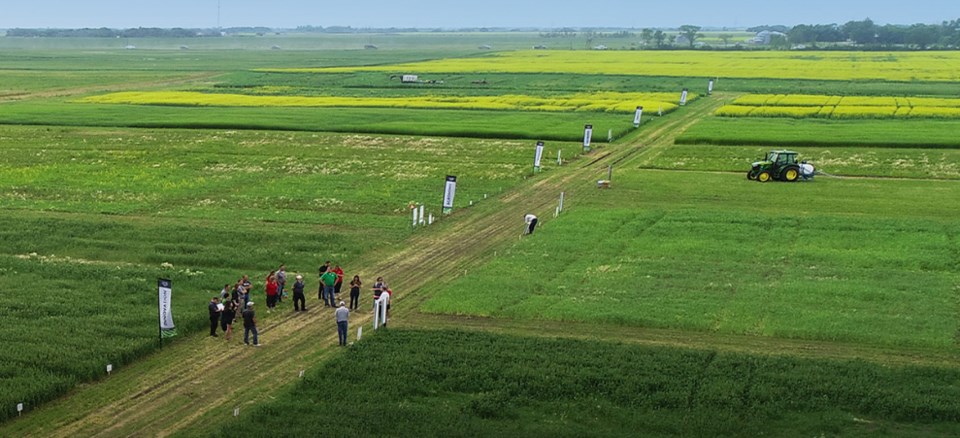In keeping with its recent water theme, the Government of Saskatchewan on July 20announced a number of agricultural water management demonstrations across the province. Some of this work is meant to drain potholes and allow that land to become usable acreage for farming.
This announcement comes a few weeks after $4 billion of irrigation development projects for central Saskatchewan centering on Lake Diefenbaker.
These demonstration projects are much smaller in scope, however, as just $1 million in funding was announced on July 20 by Minister Responsible for Water Security Agency Greg Ottenbreit.
The announcement was made in conjunction with Glacier FarmMedia Discovery Farm at Langham, which is typically host of a major summer event call Ag In Motion. However, due to the restrictions from the COVID-19 crisis, that event is not taking place this year.
(Glacier Media is the parent company of this publication as well as Glacier FarmMedia.)
One of the 11 agricultural water management demonstration projects will take place at the Discovery Farm, involving 40 acres of the 640 acre facility. Blake Weiseth spoke on behalf of the Glacier FarmMedia Discovery Farm, located at Langham.
It will be the site of a multi-year study that will involve design, regulatory approval, and construction of a drainage system on approximately 40 acres of land. After construction, a field study will evaluate several management practices meant to reduce nutrient runoff.
Some of the demonstration projects will test how farmers and ranchers can irrigate with water drained from agricultural fields. Other projects will strategically retain wetlands to reduce the downstream impacts of flooding on infrastructure, water quality and habitat. Others will look at applying fertilizer in different ways in order to minimize nutrient runoff, the release said.
“The goal is to design a drainage plan that meets regulatory requirements and optimizes land productivity while preserving the environment,” Applied Research Lead at Discovery Farm Blake Weiseth said. “This demonstration will help producers reclaim marginally productive low-lying areas while incorporating key nutrient management features associated with wetlands.”
“Marginally productive low-lying areas” are in essence what is commonly referred to as “potholes.” Weiseth referred to them as “temporary ephemeral wetlands.”
He said, “These are areas that are prone to periodic flooding throughout the growing season, depending on the amount of rainfall, of course, they might be filled with some water in the spring, or you might be able to farm through them at the beginning of the season.”
That “periodic flooding” may have a negative impact on the crop growth, Weiseth explained.
“If we apply a drainage plan to that area to try to reclaim them, perhaps we can get some better productivity over these lands, as well as overlaying that with a case management strategy to deal with those areas. So that might include looking at variable rate fertilizer application, as an example, has on managing those areas specifically,” he said.
Recent advances in aerial drone technology have made 3-D modelling of terrain much simpler. Weiseth said they are using drone-mounted LIDAR (Light Detection and Ranging) “to get very high resolution elevation data on the site, and that's a very important piece that goes into the final design of the drainage plan.”
These demonstration projects are part of a broader irrigation strategy for the province, according to Ottenbreit.
Organizations taking part in these demonstrations include:
Saskatchewan Conservation and Development Association;
Glacier FarmMedia Discovery Farm (Langham);
Saskatchewan Association of Watersheds;
Saskatchewan Irrigation Projects Association;
Saskatchewan Wildlife Federation;
Saskatchewan Soil Conservation Association;
Saskatchewan Stock Growers Association;
Saskatchewan Research Council;
Prairie Agricultural Machinery Institute.
NDP Water Security Agancy critic MLA Cathy Sproule said, “Water is an important environmental resource, and can be impacted by large scale projects. For example, unauthorized drainage issues has been rampant in Saskatchewan for many years with severe impacts on the downstream land owners. Now that the WSA is no longer under the purview of the Minister of the Environment, how will the environmental impacts of these grants be assessed? In addition, we have questions around oversight with these projects – how will the spending be accounted for, what are the metrics for success, and how will the government ensure the people of the province receive full benefit for the investment?”




